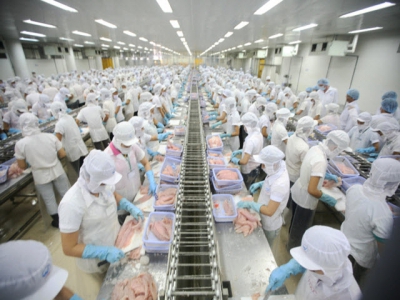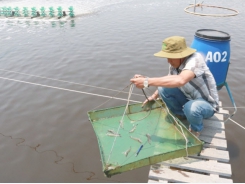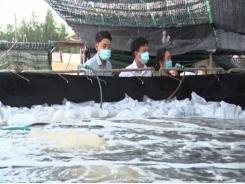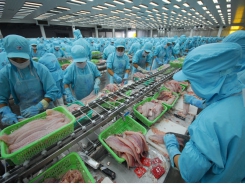A brief on Vietnams fishery development

Fishing capacity overgrew, Output far exceeded the allowable exploitation level, productivity dropped, seafood resources depleted...
Processing seafood for export. Photo: Le Hoang Vu.
In 2020, the total seafood volume reached 8.4 million tons, the export value reached USD 8.4 billion, up 4.8 times the export value in 2001 (USD 1.76 billion), Vietnam ranked third in the world in terms of seafood exports. The goal is that by 2030, the total fishery production volume will reach 9.8 million tons, of which the aquaculture production will be 7 million tons, the fishing output will be 2.8 million tons, and the seafood export value will reach USD 14 - 16 billion.
Despite great achievements, our country's seafood industry on the path of sustainable development is facing a number of challenges that require appropriate and effective solutions.
Reduce volume, increase exploitation quality
Currently, the fishing capacity in Vietnam has increased too high and the fishing output has exceeded the allowable exploitation level, the fishing productivity has decreased, and seafood resources are being depleted. In the 2021-2030 period, the policy of reducing fishing output from 3.8 million tons/year to 2.8 million tons/year is appropriate considering the reserve and ability to regenerate fishery resources.
Urgently upgrading fishing port’s infrastructure
The early increase of public investment capital and the development of policies to attract investment in infrastructure for fishing from other capital sources is of utmost importance.
In order to reduce exploitation volume, it is necessary to adjust the number of ships, apply fishing quotas, and structure occupations according to sea areas, fishing grounds and fishing seasons based on investigation and assessment of fishery resources. However, this adjustment is not solely based on the scientific basis of the aquatic resources’ assessment results. Adjustments must also consider social factors.
Improve the efficiency of brackish shrimp farming
Brackish water shrimp (black tiger shrimp, whiteleg shrimp) are the main aquaculture species of Vietnam. In 2020, the brackish water shrimp farming area is about 740,000 ha, the total shrimp production volume is estimated at 870,000 tons. The National Action Plan for the Development of Vietnam's Shrimp Industry (Decision 79/QD-TTg, January 18th, 2018) sets a target that by 2025, the total production volume of brackish water shrimp will reach 1,100,000 tons.
Reduce losses, ensure the quality of exploited products
Economic efficiency is the first and most important issue when talking about the sustainable development of shrimp farming.
Currently, the preservation of seafood on ships mainly applies cold storage with ice, which only maintains good seafood quality in a short time. The voyages of offshore fishing vessels are often long, so the quality and value of products are significantly reduced. The product storage cellar on ships made of Polyurethane insulation helps reduce product quality loss and reduce ice loss during product preservation.
Infrastructure and equipment at fishing ports play an important role, and having them upgraded will surely reduce losses for post-harvest fishery products.
Shrimp - rice, shrimp - forest farming systems are shrimp farming systems with sparse seed stock, fully utilize the natural food base in the field/pond, have low feed costs, low risk of disease, low investment, low impact on the environment, low production cost.
According to estimation, Vietnam currently has about 211,900 hectares of shrimp - rice and about 49,666 hectares of shrimp - forest areas. The farming productivity is 400-500 kg/ha in shrimp - rice system, and 200 kg/ha in shrimp - forest system. If it is possible to increase productivity, upgrade ditch system, stock quality shrimp seeds with the right density, the annual shrimp - rice and shrimp - forest areas will be able to increase hundreds of thousands of tons of commercial shrimp with high quality and low production cost.
Develop mariculture, grow seaweed
The majority of mariculture is currently focusing on aquaculture along coastal waters, straits, and islands. It can be said that mariculture has basically made full use of the coastal areas’ potential and exceeded the environmental capacity in most farming areas. This is one of the main causes of environmental pollution and disease outbreaks in coastal farming areas.
When mariculture is on an industrial scale, with large output, but the choice of mariculture species is not determined based on the assessment of demand, domestic and international market size to have appropriate solutions and guidelines, it is impossible to develop marine fish farming sustainably.
Seaweed in Vietnam holds great development potential, but is still unable to meet the domestic market’s demand at the moment.
The development of seaweed farming and marine fish farming in our country is often associated with sea areas, along with the development of technology and some other advantages (management, investment, limitations of surface area). Sunny and sandy coastal areas in the Central region of our country also hold have many potentials to develop on an industrial scale.
Producing large merchandises, associated with the market
Nowadays, in addition to producing goods according to market requirements, creating new demands (new products, new standards...) for consumers is a market development trend that has been applied by several commodity industries. Vietnam's seafood industry should also pay attention to and invest in developing new products, creating demand for new seafood products for domestic and foreign consumers.
Related news
Tools

Phối trộn thức ăn chăn nuôi

Pha dung dịch thủy canh

Định mức cho tôm ăn

Phối trộn phân bón NPK

Xác định tỷ lệ tôm sống

Chuyển đổi đơn vị phân bón

Xác định công suất sục khí

Chuyển đổi đơn vị tôm

Tính diện tích nhà kính

Tính thể tích ao




 Treatment for water environment using RAS technology
Treatment for water environment using RAS technology  Seafood industry accelerates to grasp opportunities
Seafood industry accelerates to grasp opportunities